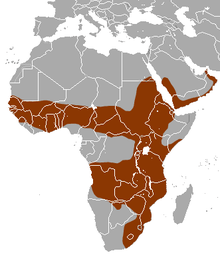White-tailed mongoose
| White-tailed mongoose[1] | |
|---|---|
| | |
| Scientific classification | |
| Kingdom: | Animalia |
| Phylum: | Chordata |
| Class: | Mammalia |
| Order: | Carnivora |
| Family: | Herpestidae |
| Subfamily: | Herpestinae |
| Genus: | Ichneumia I. Geoffroy Saint-Hilaire, 1837 |
| Species: | I. albicauda |
| Binomial name | |
| Ichneumia albicauda G. Cuvier, 1829 | |
| Subspecies | |
| |
 | |
| White-tailed mongoose range | |
The white-tailed mongoose (Ichneumia albicauda) is the largest species in the mongoose family (Herpestidae). It is the only member of the genus Ichneumia.[3]
Range and habitat
The white-tailed mongoose lives in most of Africa south of the Sahara, and the southern portion of the Arabian Peninsula.[2] They live in a wide range of habitats, from semi-desert to savanna woodland, but avoid moist areas like the Congo River basin or extremely arid areas. They prefer areas of thick cover, such as the edges of forests and brushy streams.[4]
Physical appearance
The white-tailed mongoose attains a weight range of 6.4-9.2 lb (2.9-4.2 kg), has a head-and-body length of 21-28 in (53–71 cm) and a tail length of 16-19 in (40–47 cm).[5] Its legs are relatively long for a mongoose. The head is very long and narrow and tapers to a point. Its large, rounded ears are set low on the sides of the head. It has a yellow to tan coloration on its body, with long black guard hairs, giving it an overall grizzled grey appearance. The legs and arms are black from the elbow/knee down. The base of the large, bushy tail is brownish yellow, and is white on the latter half. The tail may make up to 40% of the body length and tapers to a point. They lack hair on their upper lip and their hands from the palms to the wrists. Females have four teats.[4]
Etymology
The genus name, Ichneumia, is derived from the Greek ichneumon, which means 'tracker'. This name also happens to be the species and common name for the Egyptian mongoose (Herpestes ichneumon). The species name, albicauda, is derived from the Latin words albus, meaning 'white', and cauda, which means 'tail'.[4]
Diet
The white-tailed mongoose feeds mostly on insects, but will feed on a wide variety of other foods as well. Locusts, beetles, and mole crickets make up the majority of their diet. Rats, mice, shrews, lizards, snakes, small birds are also eaten, along with the occasional fruits and berries. The eggs of birds are also eaten; they will break open the egg by throwing it between its hind legs against a rock or other hard object. They have been known to raid chicken houses in areas where domestic poultry is raised.[4]
Behavior
Ichneumia albicauda is primarily nocturnal and terrestrial. By day they will rest in an abandoned burrow, termite mound, or in cavities under tree roots. The average home range is 0.97 km² for males and 0.64 km² for females. Ranges of males do not overlap, but ranges of opposite sexes overlap significantly. Females either live alone with their own offspring or in a small group with other females and their offspring, although they do not associate with each other. Though they may share a range, they forage separately. They are, for the most part, solitary creatures, with the male and female only coming together to mate. Reports of groups are either a breeding pair or a mother and her offspring. These mongooses do not migrate except to establish their own territory away from their mother's range.[4]
These mongooses are very vocal, and make an unusual barking sound that is associated with sexual behavior. If frightened, they will secrete a noxious substance from their anal glands. They do not stand on their hind feet for any length of time like other mongooses.[4]
Reproduction
Knowledge of the reproduction of the white tailed mongoose is incomplete. Litters are seen most frequently from February to May, and no young appear at all during the dry season from August to November, which suggests that they only breed once a year. The young are fully weaned at nine months of age, and around this time, the young disperse. It is speculated that sexual maturity is reached before two years of age, and that the gestation period is around 60 days.[4]
References
- ↑ Wilson, D.E.; Reeder, D.M., eds. (2005). "Ichneumia albicauda". Mammal Species of the World: A Taxonomic and Geographic Reference (3rd ed.). Johns Hopkins University Press. ISBN 978-0-8018-8221-0. OCLC 62265494.
- 1 2 Hoffmann, M. (2008). "Ichneumia albicauda". IUCN Red List of Threatened Species. Version 2010.1. International Union for Conservation of Nature. Retrieved 14 June 2010. Database entry includes a brief justification of why this species is of least concern
- ↑ Wilson, D.E.; Reeder, D.M., eds. (2005). "Ichneumia". Mammal Species of the World: A Taxonomic and Geographic Reference (3rd ed.). Johns Hopkins University Press. ISBN 978-0-8018-8221-0. OCLC 62265494.
- 1 2 3 4 5 6 7 Dewey, T. and N. Greene. 1999. Ichneumia albicauda at Animal Diversity Web. Accessed June 14, 2010.
- ↑ Estes, Richard D. (1999). The Safari Companion. Chelsea Green Publishing Company. p. 261. ISBN 1890132446.
External links
| Wikispecies has information related to: Ichneumia |
| Wikimedia Commons has media related to Ichneumia albicauda. |
